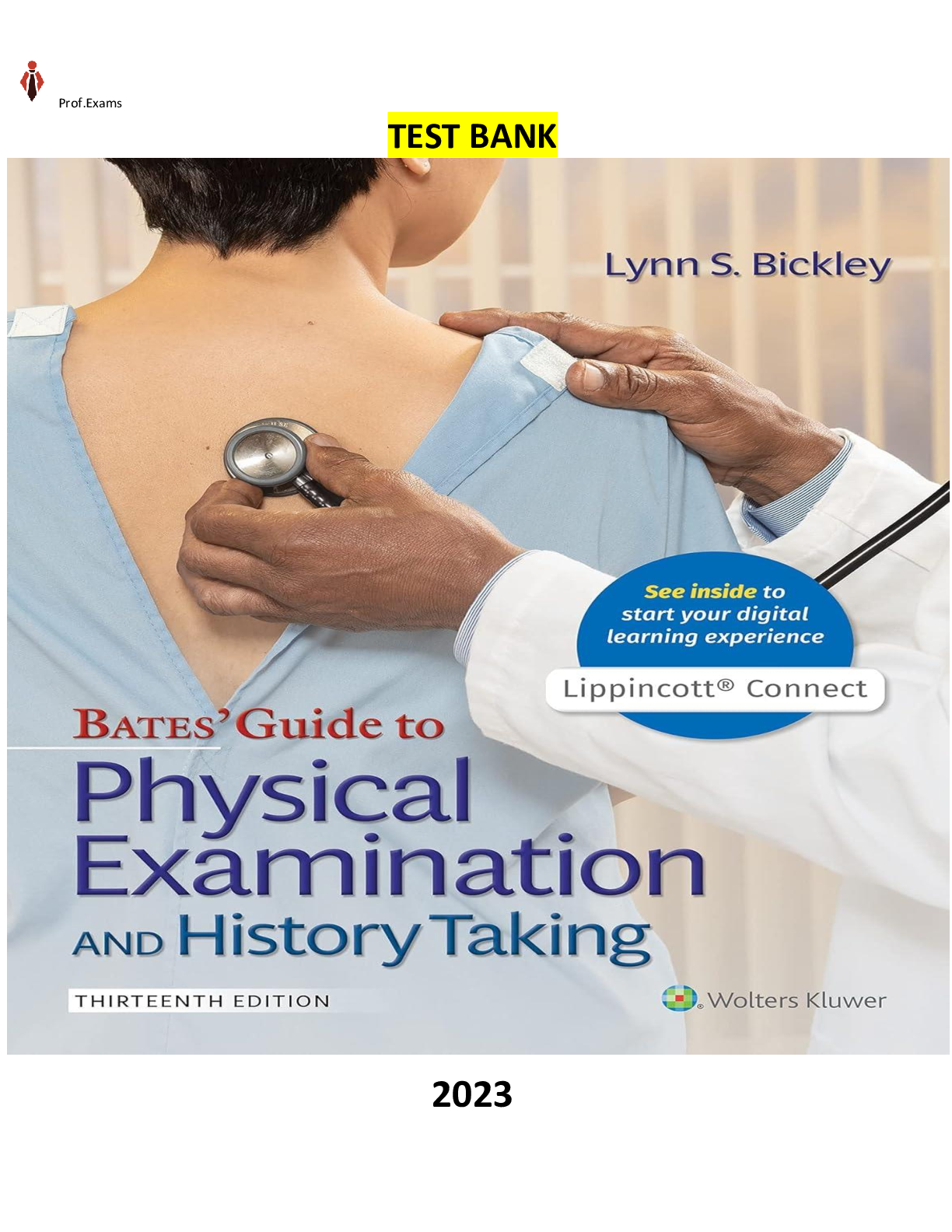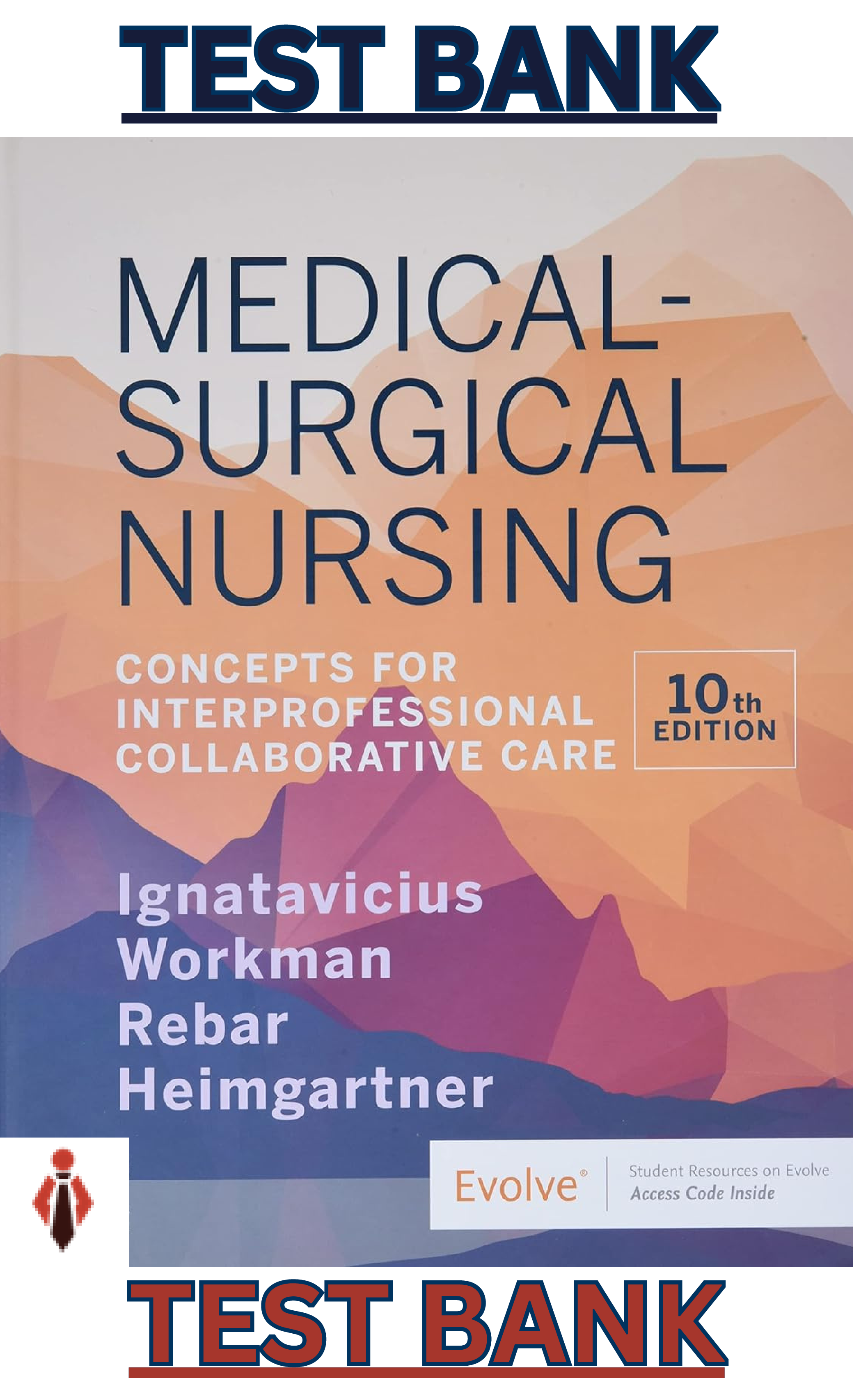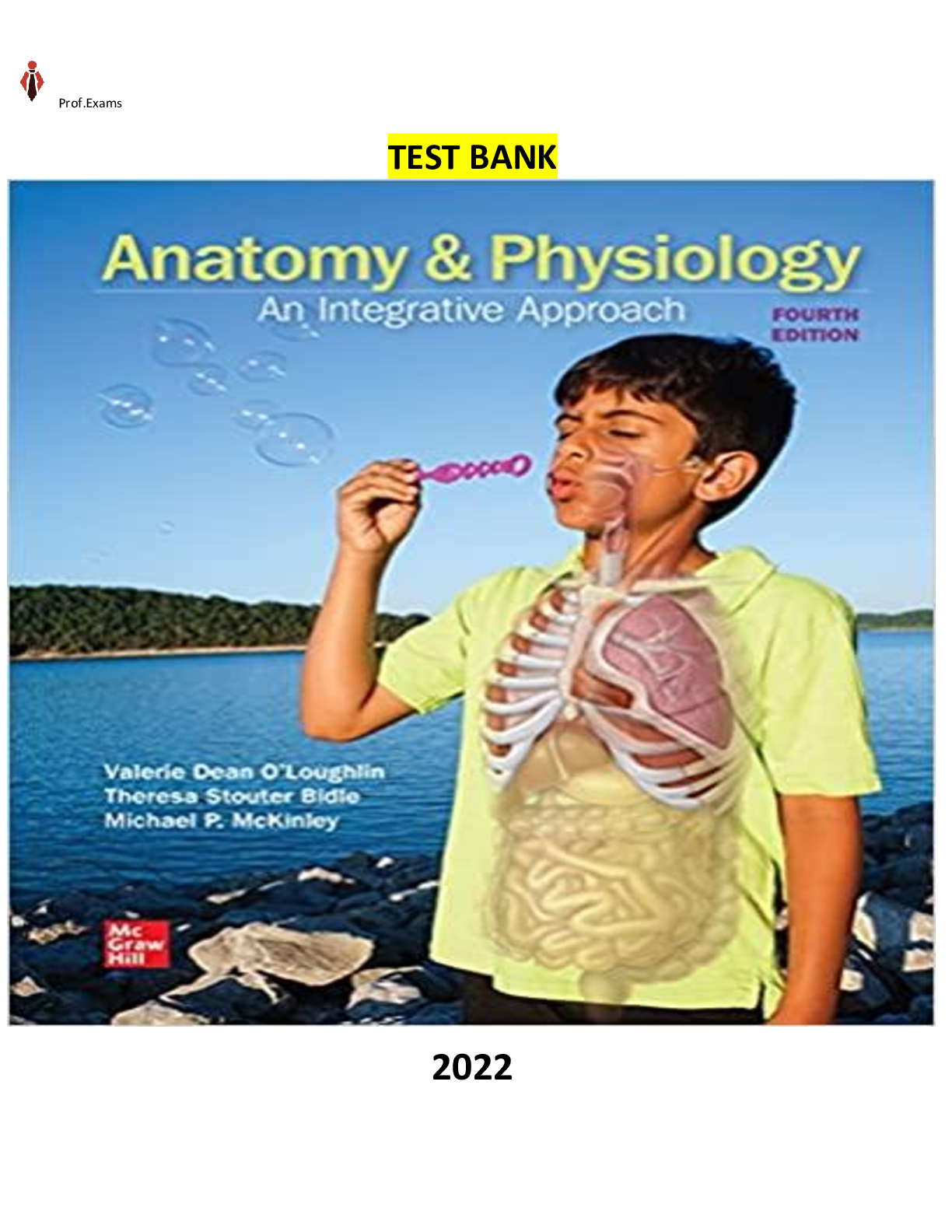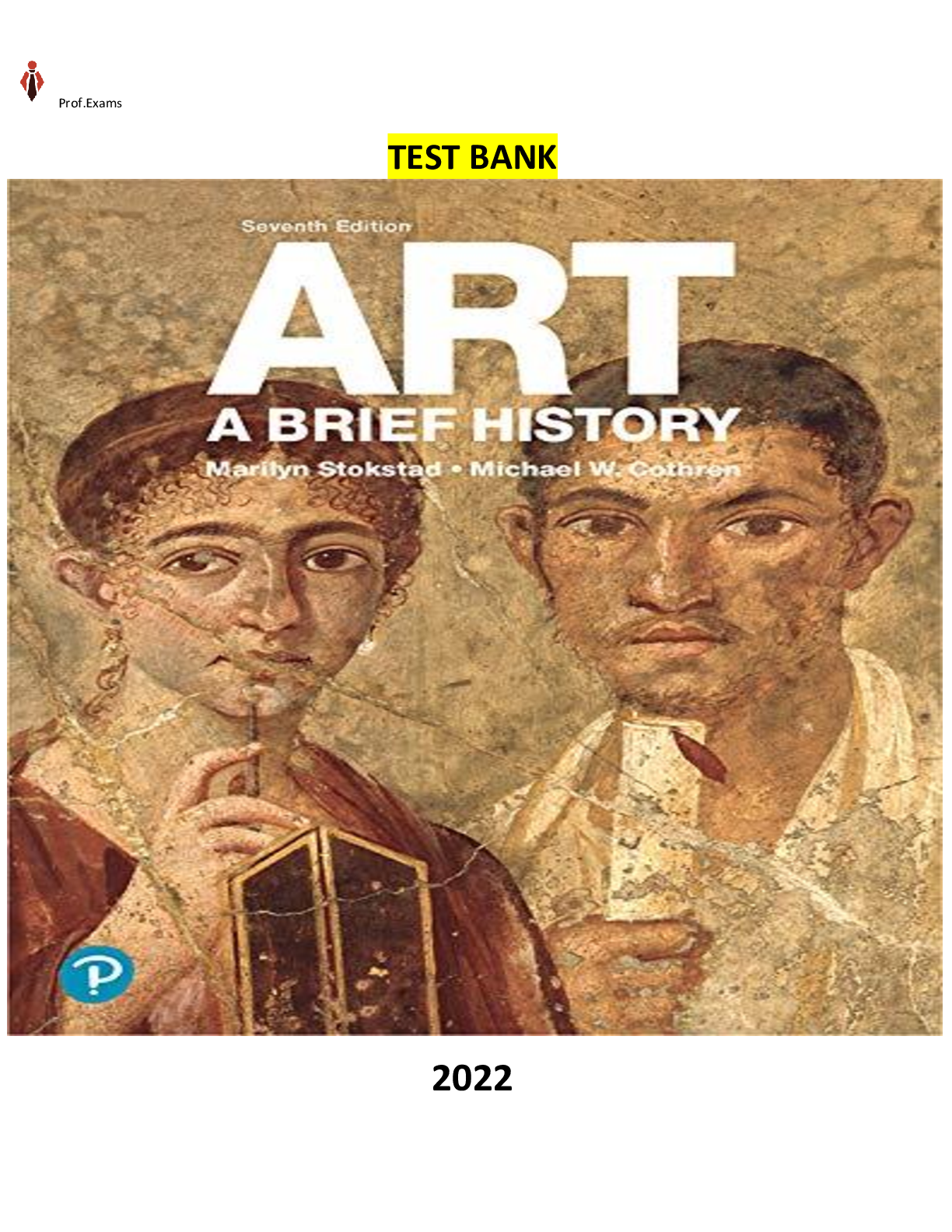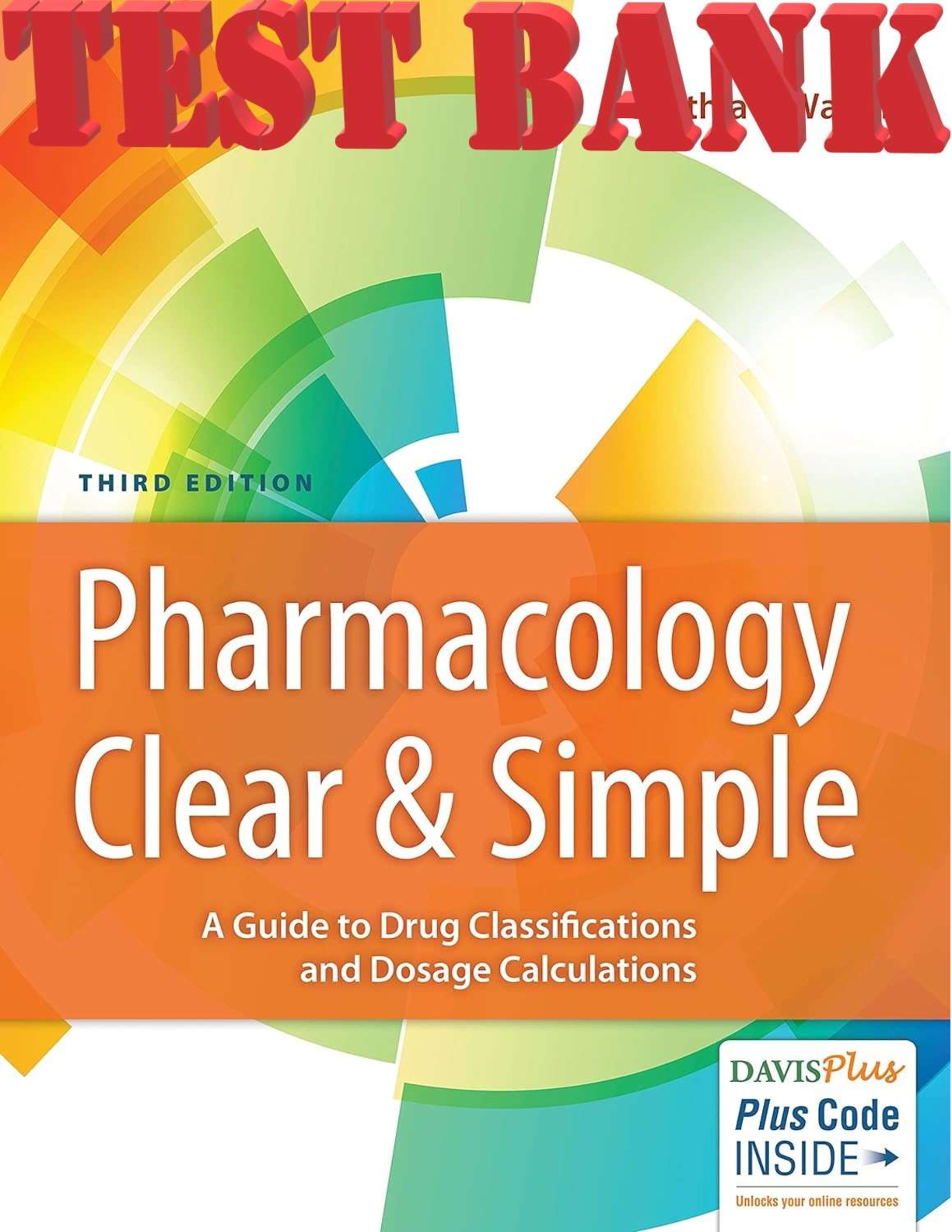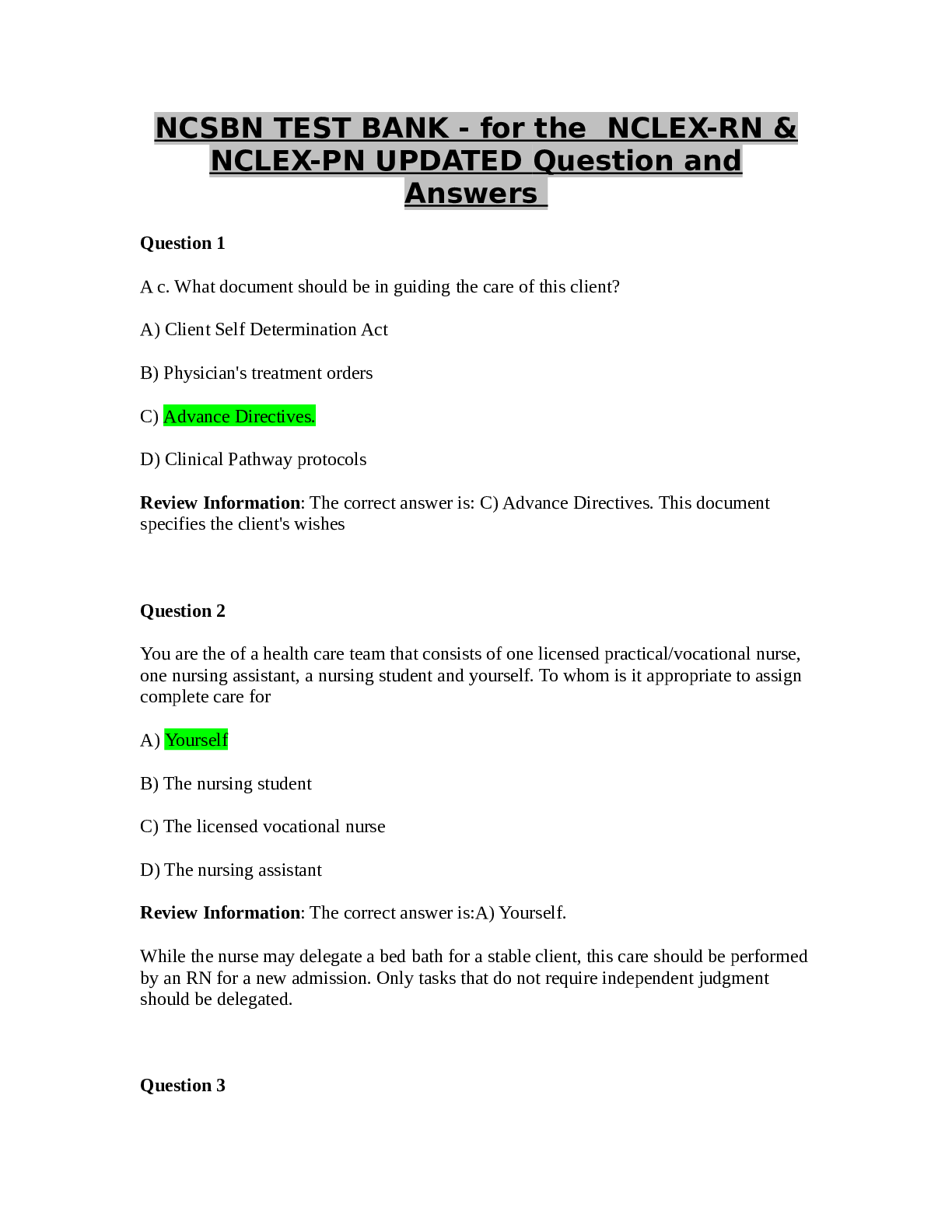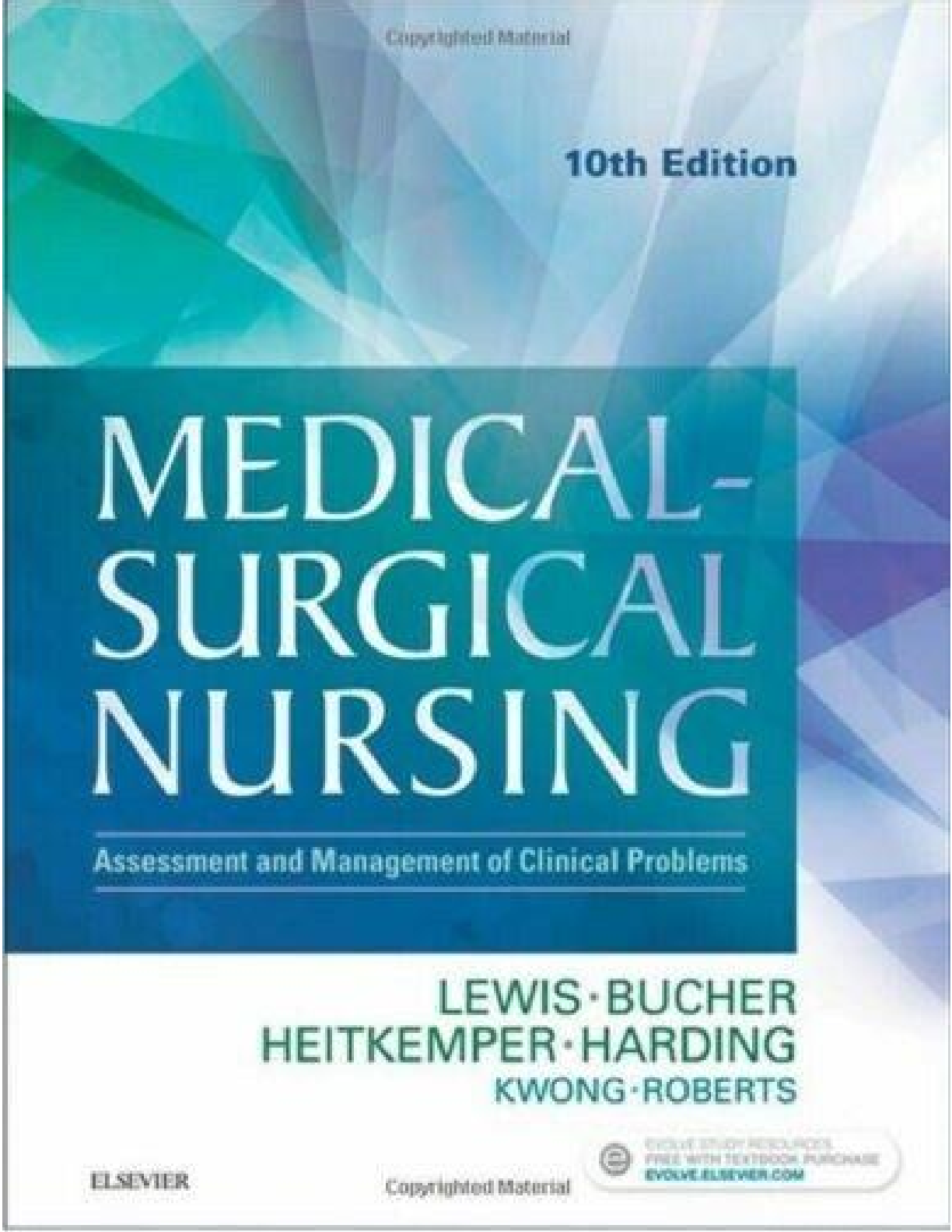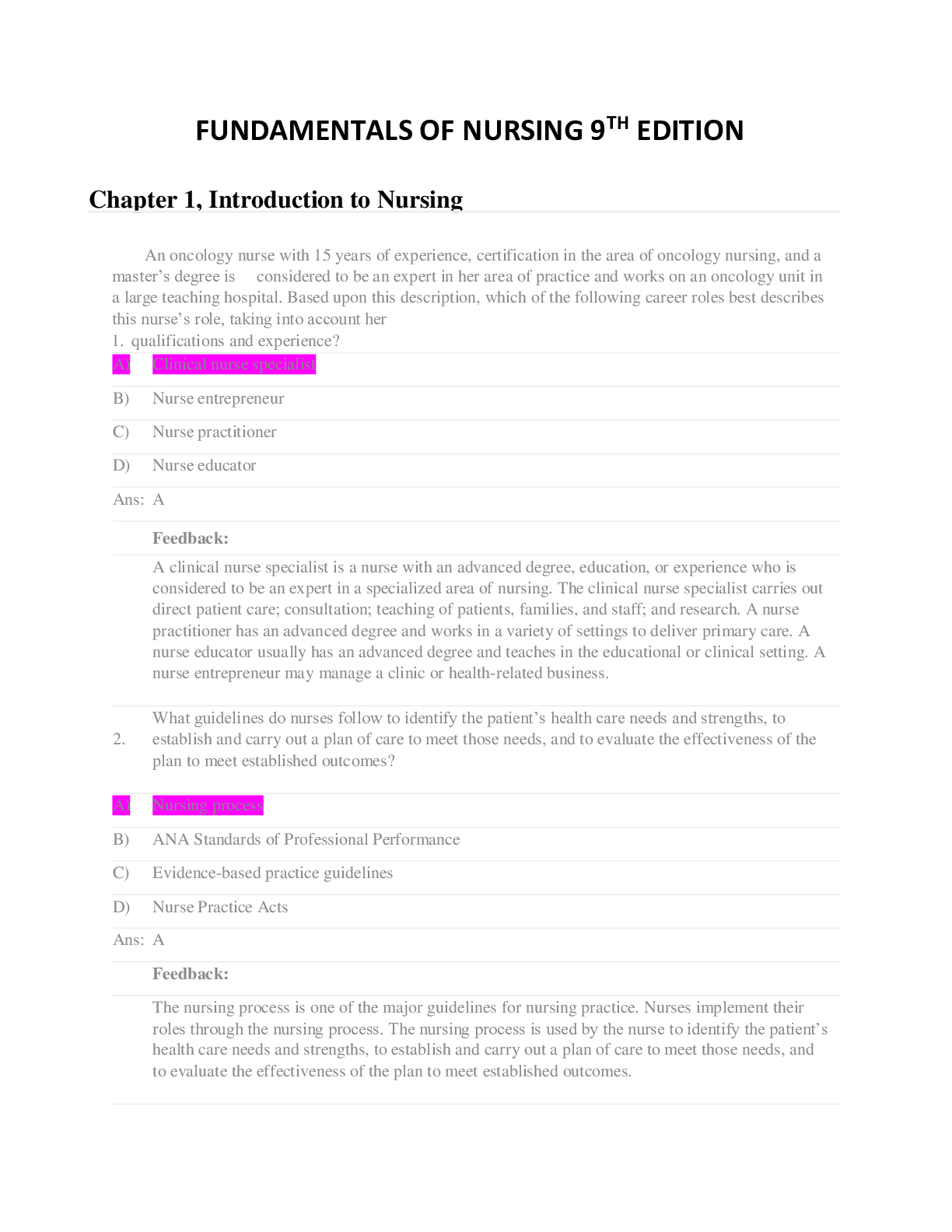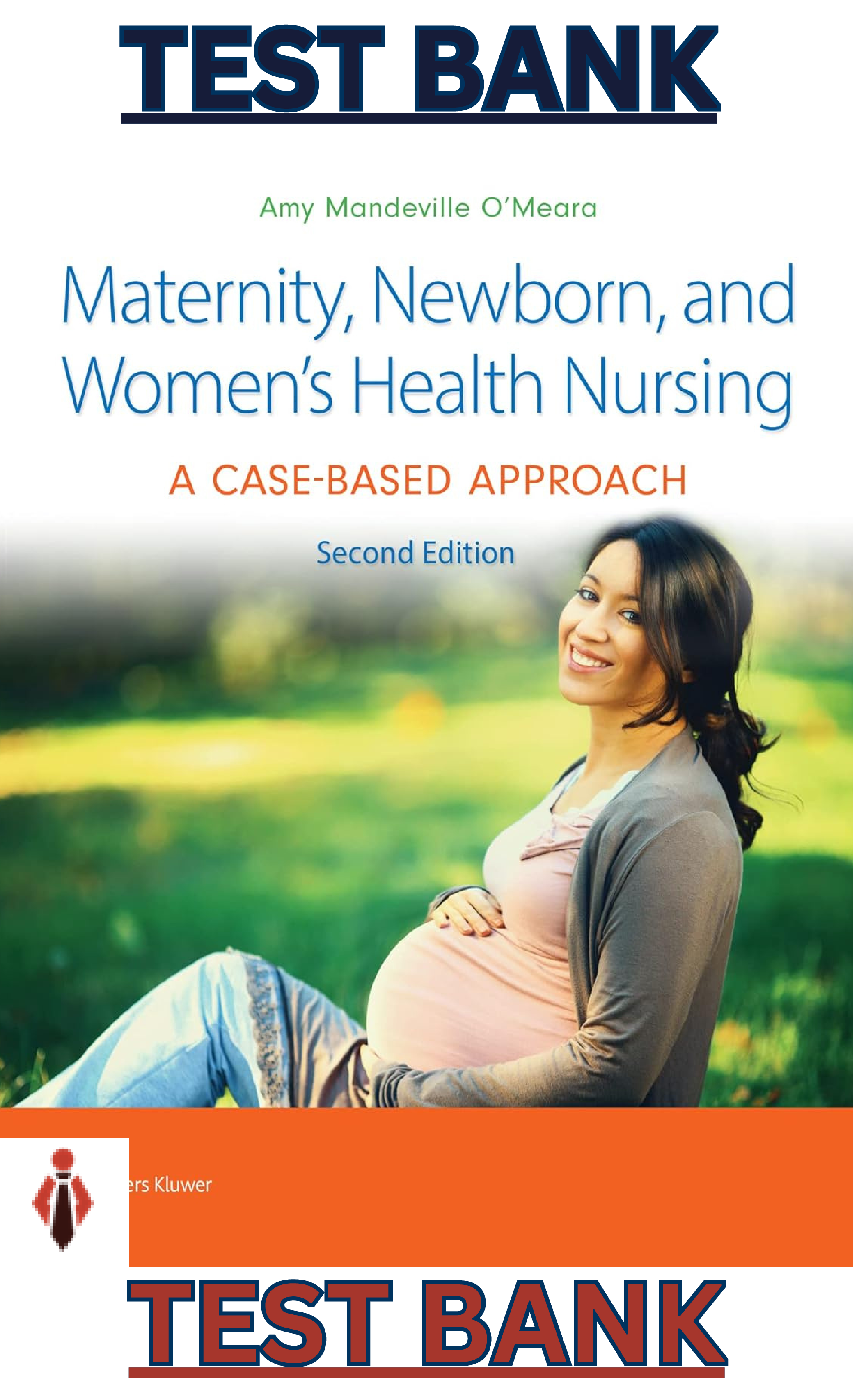Pharmacology > TEST BANKS > Test Bank - Pharmacology Clear and Simple-A Guide to Drug Classifications and Dosage Calculations 4E (All)
Test Bank - Pharmacology Clear and Simple-A Guide to Drug Classifications and Dosage Calculations 4Ed.by Cynthia J. Watkins - Complete, Elaborated and Latest Test Bank. ALL Chapters (1-21) Included and Updated for 2023
Document Content and Description Below
Test Bank - Pharmacology Clear and Simple-A Guide to Drug Classifications and Dosage Calculations 4Ed.by Cynthia J. Watkins - Complete, Elaborated and Latest Test Bank. ALL Chapters (1-21) Included an... d Updated for 2023 #PharmacologyBasics #DrugClassifications #DosageCalculations #PatientSafety #MedicationAdministration #RegulationsInPharmacology #PrescriptionsAndLabels #MathReview #MeasurementSystems #EnteralMedications #ParenteralMedications #IntegumentarySystemDrugs #NervousSystemDrugs #CardiovascularDrugs #ComplementaryMedicine I. Introduction to Pharmacology Chapter: 1. History of Pharmacology Chapter: 2. Basics of Pharmacology Chapter: 3. Patient Safety in Medication Administration Chapter: 4. Regulations Chapter: 5. Prescriptions and Labels II. Calculations Chapter: 6. Basic Review of Mathematics Chapter: 7. Measurement Systems Chapter: 8. Dosage Calculations III. Administration of Medications Chapter: 9. Enteral Medications and Administration Chapter: 10. Parenteral Medications and Administration Chapter: IV. Classifications of Drugs Chapter: 11. Integumentary System Medications Chapter: 12. Musculoskeletal System Medications Chapter: 13. Nervous System Medications Chapter: 14. Eye and Ear Medications Chapter: 15. Endocrine System Medications Chapter: 16. Cardiovascular System Medications Chapter: 17. Immunological System Medications Chapter: 18. Pulmonary System Medications Chapter: 19. Gastrointestinal System Medications Chapter: 20. Reproductive and Urinary Systems Medications Chapter: 21. Vitamins, Minerals, Herbs, and Complementary and Alternative Medicine Test Bank - Pharmacology Clear-Simple-Guide to Drug Classifications & Dosage 4E-Watkins|2003 Updated| COMPLETE - Elaborated Test bank for Pharmacology Clear and Simple-A Guide to Drug Classifications and Dosage Calculations 4Ed.by Cynthia J. Watkins . ALL Chapters(1-21) Included |271| Pages - Questions & Answers COMPLETE - Elaborated Test bank for Pharmacology Clear and Simple-A Guide to Drug Classifications and Dosage Calculations 4Ed.by Cynthia J. Watkins . ALL Chapters(1-21) Included |271| Pages - Questions & Answers Pass Basic Fundamentals of Nursing in First Attempt Guaranteed!Get 100% Latest Exam Questions, Accurate & Verified Answers to Pass the Actual Exam! Instant Download! Pharmacology Clear and Simple-A Guide to Drug Classifications and Dosage Calculations 4Ed.by Cynthia J. Watkins ISBN-10 1719644748 ISBN-13 978-1719644747 I. Introduction to Pharmacology 1. History of Pharmacology 2. Basics of Pharmacology 3. Patient Safety in Medication Administration 4. Regulations 5. Prescriptions and Labels II. Calculations 6. Basic Review of Mathematics 7. Measurement Systems 8. Dosage Calculations III. Administration of Medications 9. Enteral Medications and Administration 10. Parenteral Medications and Administration IV. Classifications of Drugs 11. Integumentary System Medications 12. Musculoskeletal System Medications 13. Nervous System Medications 14. Eye and Ear Medications 15. Endocrine System Medications 16. Cardiovascular System Medications 17. Immunological System Medications 18. Pulmonary System Medications 19. Gastrointestinal System Medications 20. Reproductive and Urinary Systems Medications 21. Vitamins, Minerals, Herbs, and Complementary and Alternative Medicine Identify the choice that best completes the statement or answers the question. 1. Which of the following is the process of a substance moving from where it was administered into the bloodstream? a. Absorption c. Excretion b. Distribution d. Metabolism 2. Which of the following routes has the quickest absorption into the bloodstream? a. Inhalation b. Oral c. Intravenous d. Intramuscular e. Subcutaneous 3. Drugs that cross the blood–brain barrier are called which of the following? a. OTC b. Psychotropic c. Teratogenic d. Controlled e. Prescription 4. Which organ(s) metabolize(s) medications? a. Liver b. Kidneys c. Intestines d. Stomach e. Liver, kidneys, and intestines 5. The process by which the liver metabolizes drugs to change them is called which of the following? a. Absorption b. Distribution c. Biotransformation d. Excretion e. Cirrhosis 6. Which of the following organs excrete(s) drugs? a. Mouth b. Stomach c. Breasts d. Pancreas e. Liver Copyright © 2022 F.A. Davis Company 2 7. Ototoxicity is damage to which of the following? a. Liver b. Eye c. Ear d. Pancreas e. Stomach 8. A unique reaction to a drug is called which of the following? a. Side effect b. Idiosyncrasy c. Ototoxicity d. Teratogen e. Oncogene 9. Which of the following refers to not excreting drugs effectively? a. Teratogenic b. Oncogenic c. Antagonistic d. Agonistic e. Cumulation 10. A drug that is given orally but acts in another area is called which of the following? a. Systemic b. Synthetic c. Synergistic d. Toxic e. Efficacious 11. Which of the following has an intended action of delayed clotting? a. Coumadin b. Ritalin c. Valproic acid d. Lithium e. OxyContin 12. Which of the following is not a stage of the drug cycle? a. Absorption b. Distribution c. Isolation d. Metabolism e. Excretion Copyright © 2022 F.A. Davis Company 3 13. The rate of medication absorption is affected by which of the following? a. Amount of food in the stomach b. Age of the patient c. Concentration of the medication d. pH of the medication e. Amount of food in the stomach, age of the patient, concentration of the medication, and pH of the medication. 14. Medications with which pH are more easily absorbed in the stomach? a. Acidic c. Neutral b. Alkalotic d. All are absorbed equally 15. Drugs that can pass through the blood–placental barrier to harm the fetus include which of the following? a. Alcohol c. Tylenol b. Cocaine d. Alcohol and cocaine 16. Metabolism is also known as which of the following? a. Biotransformation c. Breakdown b. Biometabolism d. Fusion 17. Lexiva is a drug given in its inactive form that is activated through metabolism to treat HIV. This type of drug is known as which of the following? a. An inactive drug c. A change drug b. A prodrug d. None of the above 18. Routes through which medications are excreted from the body include which of the following? a. Kidneys b. Lungs c. Bile d. Breast milk e. Kidneys, lungs, bile, and breast milk 19. What organ is most commonly responsible for the excretion of medication from the body? a. Kidney c. Pancreas b. Liver d. Intestine 20. Which organ is affected when a medication is nephrotoxic? a. Kidney c. Pancreas b. Liver d. Intestine 21. The effect of two medications that is more powerful than if each were taken separately is known as which of the following? a. Antagonism c. Adverse reactions b. Synergism d. Building blocks 22. The administration route with the least risk of side effects is which of the following? a. Systemic c. Topical b. Transdermal d. Systemic, transdermal, and topical Copyright © 2022 F.A. Davis Company 4 23. One symptom of liver damage caused by the effect of medication is which of the following? a. Jaundice c. Headaches b. Tremors d. Jaundice, tremors, and headaches 24. One way to counteract the gastrointestinal (GI) side effect of diarrhea is to eat which of the following? a. Cheese c. Yogurt b. Crackers d. Fiber 25. One way to counteract the GI side effect of constipation is to add what to your diet? a. Cheese c. Yogurt b. Crackers d. Fiber Matching Match the following terms with their definitions. a. Blood–placental barrier c. Blood–testicular barrier b. Blood–brain barrier 26. Barrier that keeps most medications from reaching the central nervous system 27. Barrier that protects the fetus during pregnancy 28. Barrier that protects the sperm in males Match the following terms with their definitions. a. Agonist d. Side effects b. Antagonist e. Receptors c. Adverse reaction 29. Two drugs taken together that can make a drug less powerful 30. Mild reactions to medications, such as nausea and constipation 31. Two drugs taken together to make each work more effectively than when taken alone 32. Sites where medications bind to create a physiologic effect 33. Severe reaction to a medication that may cause a prescriber to change the medication being taken Match the following drug resources with their definitions. a. United States Pharmacopeia/National Formulary (USP/NF) b. United States Pharmacopeia/Dispensing Information (USP/DI) c. Physician’s Desk Reference. [Show More]
Last updated: 1 year ago
Preview 1 out of 271 pages
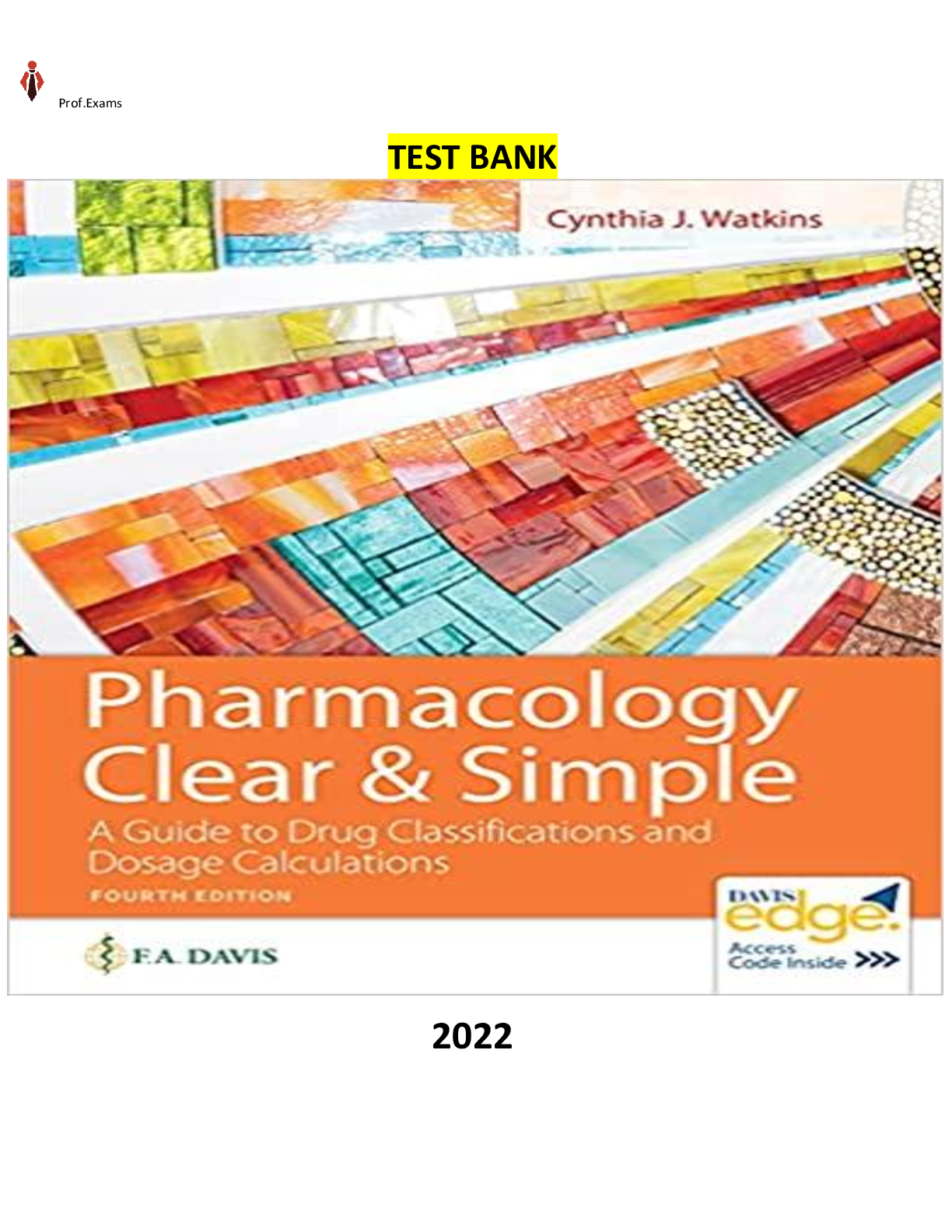
Buy this document to get the full access instantly
Instant Download Access after purchase
Buy NowInstant download
We Accept:

Reviews( 0 )
$36.00
Can't find what you want? Try our AI powered Search
Document information
Connected school, study & course
About the document
Uploaded On
May 16, 2023
Number of pages
271
Written in
Additional information
This document has been written for:
Uploaded
May 16, 2023
Downloads
0
Views
144


